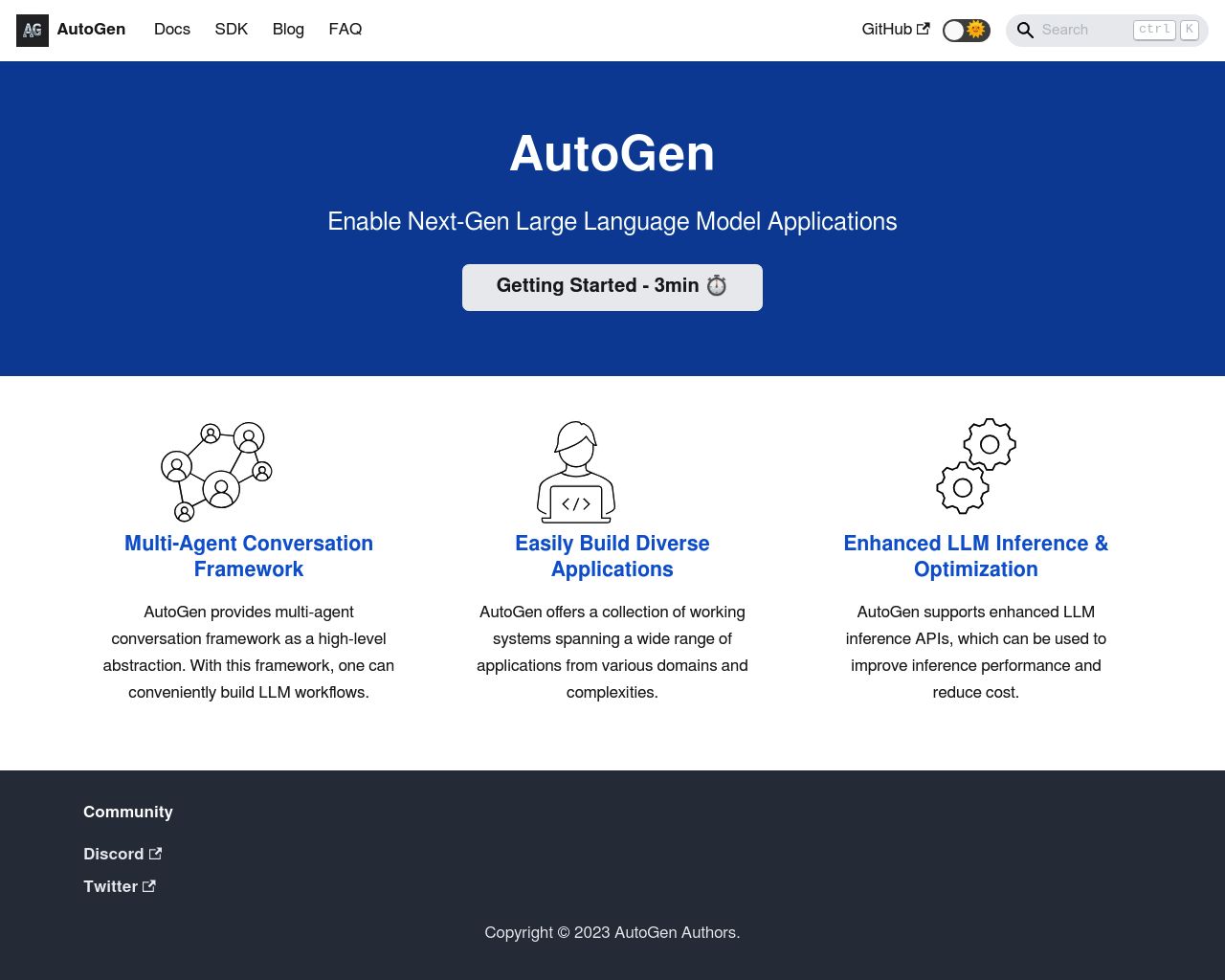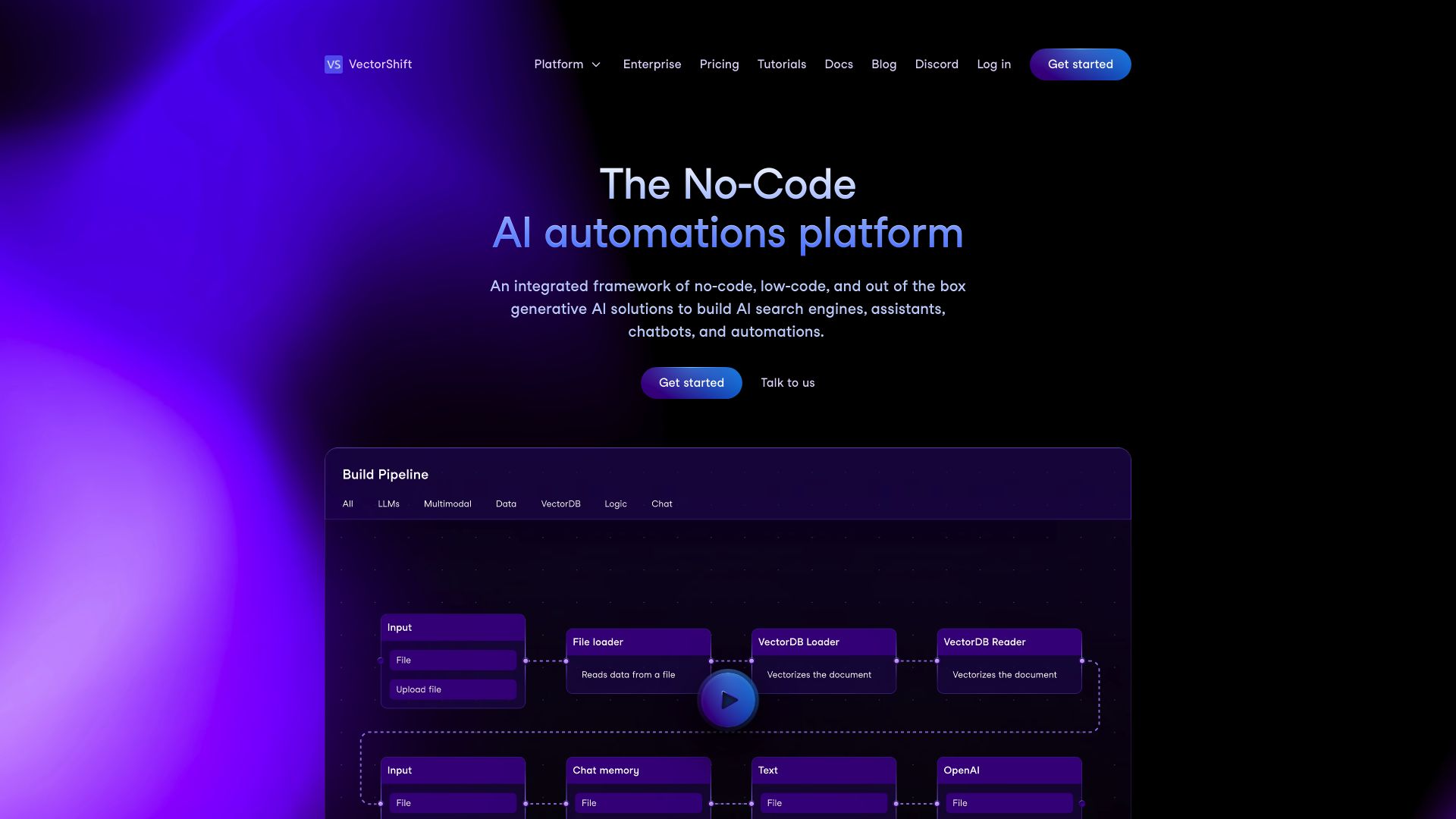AI agent development platforms AutoGen vs. VectorShift, and SmythOS are reshaping how businesses harness artificial intelligence. This comparison explores each platform’s unique strengths in multi-agent collaboration, workflow automation, and user-friendly development.
We’ll examine key features, integration capabilities, and deployment options to help you select the ideal solution for your AI initiatives. Whether you’re a seasoned developer or a business leader exploring AI automation, this guide offers insights to inform your decision and maximize the potential of conversational AI in your organization.
AutoGen Overview
AutoGen empowers developers to build sophisticated Large Language Model (LLM) applications through multi-agent conversations. This open-source framework orchestrates customizable AI agents that collaborate to tackle complex tasks autonomously or with human input.


AutoGen maximizes LLM performance with enhanced inference capabilities, including tuning, caching, and error handling. Developers can create tailored agents integrating LLMs, human inputs, and various tools. The framework supports both fully autonomous operations and human-in-the-loop problem-solving, adapting to diverse application needs.
AutoGen empowers developers to build sophisticated Large Language Model (LLM) applications through multi-agent conversations.
AutoGen demonstrates effectiveness across a wide range of applications, from automated task solving and code generation to continual learning and complex problem-solving in group chats. For developers, it offers debugging tools and logging functionalities crucial for optimizing LLM-based systems. The inclusion of EcoOptiGen, a cost-effective LLM tuning technique, highlights AutoGen’s focus on enhancing efficiency.
While AutoGen offers powerful capabilities, it requires coding knowledge for setup and lacks a visual builder or no-code editor. This may present a learning curve for non-technical users. However, its flexibility and extensive features make it a robust choice for developers and organizations looking to harness the full potential of conversational AI and LLM applications.
VectorShift Overview
VectorShift empowers users to create, prototype, and manage generative AI workflows through a versatile platform. The software caters to both technical and non-technical users with its dual-interface approach, offering a no-code builder and a code SDK.
VectorShift’s platform excels in automating diverse AI-driven tasks, from chatbots to content creation. Users can design end-to-end workflows, schedule automated processes, and trigger actions based on specific events. The software seamlessly integrates with popular data sources like Google Drive, Slack, and Airtable, centralizing data management across applications.
VectorShift’s platform excels in automating diverse AI-driven tasks, from chatbots to content creation. Users can design end-to-end workflows, schedule automated processes, and trigger actions based on specific events.


At the core of VectorShift lies the pipeline dashboard, allowing users to build AI workflows from scratch or using templates. This feature streamlines the deployment process, making it accessible for users with varying levels of technical expertise. The platform’s robust knowledge base enhances AI accuracy by centralizing data and enabling semantic searches.
VectorShift offers flexible deployment options, allowing users to implement their AI solutions as chatbots, automations, or search functions. Customization choices include URL deployment, iFrame embedding, WhatsApp/SMS bots, API endpoints, and Slack App integration.
While VectorShift provides a comprehensive suite of features, it may face challenges in highly specialized use cases requiring extensive customization. The platform’s focus on accessibility and versatility positions it as a strong contender for businesses seeking to leverage AI without deep technical expertise, though advanced users might find some limitations in fine-tuning complex workflows.
Feature Comparison
AutoGen and VectorShift both offer powerful capabilities for building AI agents, but with some key differences. AutoGen excels in enabling multi-agent collaboration and enhanced Large Language Model inference. It provides a flexible framework for developers to create customizable, conversable agents that can interact autonomously or with human input. AutoGen’s strength lies in its support for complex problem-solving through agent teamwork and its robust debugging tools.
VectorShift, on the other hand, focuses on accessibility and versatility. It offers both a no-code builder and a code SDK, making it more approachable for non-technical users. VectorShift’s platform emphasizes end-to-end workflow automation, scheduled processes, and event-triggered actions. It provides more extensive integration options with popular data sources and deployment flexibility, allowing AI solutions to be implemented as chatbots, automations, or search functions.
In terms of core components, AutoGen lacks a visual builder and no-code editor, requiring coding knowledge for setup. This contrasts with VectorShift’s dual-interface approach. For security, neither platform explicitly mentions features like constrained alignment or data encryption, though AutoGen supports OAuth authentication. Both platforms offer deployment options, but VectorShift provides more diverse choices, including URL deployment and iFrame embedding. While both tools aim to democratize AI development, they cater to different user bases — AutoGen for more technically-inclined developers and VectorShift for a broader range of users seeking accessible AI automation solutions.
Feature Comparison Table
| AutoGen | VectorShift | SmythOS | |
|---|---|---|---|
| CORE FEATURES | |||
| Hosted Agents (Dev, Production) | ✅ | ❌ | ✅ |
| Environments (Dev, Production) | ✅ | ❌ | ✅ |
| Visual Builder | ❌ | ✅ | ✅ |
| No-Code Options | ❌ | ✅ | ✅ |
| Autonomous Agents | ✅ | ❌ | ✅ |
| Explainability & Transparency | ✅ | ❌ | ✅ |
| Debug Tools | ✅ | ❌ | ✅ |
| Multi-Agent Collaboration | ✅ | ❌ | ✅ |
| Audit Logs for Analytics | ✅ | ❌ | ✅ |
| Agent Work Scheduler | ❌ | ✅ | ✅ |
| SECURITY | |||
| Constrained Alignment | ❌ | ❌ | ✅ |
| Data Encryption | ✅ | ❌ | ✅ |
| IP Control | ❌ | ❌ | ✅ |
| COMPONENTS | |||
| Huggingface AIs | ✅ | ❌ | ✅ |
| Zapier APIs | ✅ | ❌ | ✅ |
| Classifiers | ✅ | ❌ | ✅ |
| Data Lakes | ❌ | ❌ | ✅ |
| DEPLOYMENT OPTIONS (EMBODIMENTS) | |||
| Staging Domains | ❌ | ❌ | ✅ |
| Production Domains | ❌ | ❌ | ✅ |
| Deploy as Scheduled Agent | ❌ | ✅ | ✅ |
| Deploy as GPT | ✅ | ❌ | ✅ |
| DATA LAKE SUPPORT | |||
| Hosted Vector Database | ❌ | ✅ | ✅ |
| Sitemap Crawler | ❌ | ❌ | ✅ |
| YouTube Transcript Crawler | ❌ | ✅ | ✅ |
Best Alternative to AutoGen and VectorShift
SmythOS stands out as the superior alternative to AutoGen and VectorShift for AI agent development and deployment. Our platform combines the best of both worlds, offering a powerful, flexible system that caters to technical experts and non-coders alike. We provide a visual drag-and-drop interface alongside robust coding options, enabling users of all skill levels to create sophisticated AI agents quickly and efficiently.
Unlike AutoGen’s developer-centric approach or VectorShift’s limited autonomous capabilities, SmythOS delivers true end-to-end agent autonomy. Our agents can operate independently, tackling complex tasks and collaborating seamlessly in multi-agent systems. This unparalleled autonomy significantly reduces the need for human intervention, allowing businesses to automate more processes and focus on high-value activities.
SmythOS delivers true end-to-end agent autonomy. Our agents can operate independently, tackling complex tasks and collaborating seamlessly in multi-agent systems.
Security and scalability set SmythOS apart from competitors. We implement advanced features like constrained alignment and data encryption, ensuring your AI agents operate within defined parameters and protect sensitive information. Our platform scales effortlessly to meet enterprise-level demands, supporting deployment across multiple environments and domains. This robust infrastructure provides the reliability and flexibility necessary for mission-critical AI applications.
SmythOS excels in its comprehensive integration capabilities. We support a vast array of AI models, APIs, and data sources, including popular options like Hugging Face and Zapier. This extensive ecosystem allows for seamless incorporation of AI agents into existing workflows and systems. Whether you’re building a customer service chatbot, automating data analysis, or developing complex decision-making tools, SmythOS provides the components and connections needed to bring your vision to life.
By choosing SmythOS, you’re not just selecting a tool – you’re embracing a platform that continuously evolves to meet the challenges of modern AI development. Our commitment to innovation, coupled with our user-friendly approach, makes SmythOS the ideal choice for organizations looking to harness the full potential of AI agents without sacrificing ease of use, security, or scalability.
Conclusion
AutoGen, VectorShift, and SmythOS each offer unique approaches to AI agent development and deployment. AutoGen excels in multi-agent collaboration and enhanced LLM inference, catering to developers seeking complex problem-solving capabilities. VectorShift provides accessibility through its dual-interface approach, appealing to both technical and non-technical users with its focus on workflow automation and integration options.
SmythOS, however, stands out as the superior choice, combining the strengths of both platforms while addressing their limitations. Our drag-and-drop interface surpasses VectorShift’s no-code builder, offering unparalleled ease of use without sacrificing advanced capabilities. Unlike AutoGen, SmythOS requires no coding knowledge, making AI development accessible to a broader audience.
We pride ourselves on our extensive integration ecosystem, supporting over 300,000 integrations and a wide array of AI models. This versatility, coupled with our ’Create Once, Deploy Anywhere’ philosophy, enables users to build and deploy AI agents across multiple platforms effortlessly. Our multi-agent orchestration capabilities rival AutoGen’s, while our pre-built templates and API integrations streamline development processes far beyond what VectorShift offers.
For those ready to experience the future of AI agent development, we invite you to explore our diverse range of AI-powered agent templates. These templates cover multiple business categories and offer a springboard for your AI initiatives. To truly unlock the potential of AI for your organization, create a free SmythOS account and start building unlimited AI agents at no cost. With our 30-day money-back guarantee, you can automate anything risk-free and discover why SmythOS is the ultimate choice for AI-powered innovation.